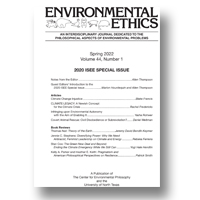|
articles |
|
1.
|
Environmental Ethics:
Volume >
45 >
Issue: 2
Bengt Brülde, U. Martin Persson, Lina Eriksson, Fredrik Hedenus
Whose Fault Is It?:
An Account of Complicity in Unstructured Collective Harms
abstract |
view |
rights & permissions
| cited by
Many of the major challenges facing global society are unstructured collective harms (e.g., global warming): collective in the sense that they arise as the result of the actions of, or interactions among, multiple agents, and unstructured in the sense that there is no coordination or intention to cause harm among these agents. But how should we distribute moral responsibility for these harms? In this paper, an answer is proposed to this question. This answer builds on but develops existing proposals by drawing together literatures that speak to different aspects of the question. First, it is argued that the notion of causal contribution needs to be broadened to include the idea of causation as production. Second, it is discussed how the voluntariness and foreseeability conditions are best interpreted in this context. Third, literature on moral taint is drawn to introduce additional objective (external) criteria.
|
|
|
|
|
2.
|
Environmental Ethics:
Volume >
45 >
Issue: 2
Rich Eva
Thomistic Environmental Ethics:
God’s Artistic Property
abstract |
view |
rights & permissions
| cited by
A cursory reading of Thomas Aquinas’s work can give the impression he condones a despotic or exploitative relationship between humans and the environment. Many philosophers and theologians have sought to dispel this impression and draw out a more robust Thomistic environmental ethic. In this paper, I support this endeavor by describing how, in Thomas’s work, the environment is God’s artistic property and how this notion qualifies our use of the environment. Next, I consider two concepts related to artistic property: vandalism and showcasing. I explore these concepts as they relate to the environment and find they give us reasons not to deface or destroy creatures and to look to creation for guidance in problem-solving.
|
|
|
|
|
3.
|
Environmental Ethics:
Volume >
45 >
Issue: 2
Diana-Abasi Ibanga
Ndu-Mmili-Ndu-Azu ("Live-and-Let-Live"):
Ekwealo’s Version of Environmental Ethics
abstract |
view |
rights & permissions
| cited by
In three parts, this article sketches the version of African environmental ethics that was developed and promoted by Chigbo Ekwealo who was a renowned environmental philosopher in Africa. The first part is a sketch of the principles and doctrine of his environmental ethics. The second part traces the intellectual history of his environmental ethics, the influences on it and its influence on the global environmental ethics movement. The third part is a critique of his environmental ethics based on contemporary and global circumstances. It is demonstrated how Ekwealo’s environmental ethics attempted to consciously depart from earlier versions of African environmental ethics in terms of its rejection of the neo-materialist, polemical, and supernatural features of other views. This article contributes to a reconstruction of the environmental thought of one of the founders of the African environmental movement whose thoughts are not accessible to most contemporary environmental philosophers today.
|
|
|
|
|
4.
|
Environmental Ethics:
Volume >
45 >
Issue: 2
Eric Katz
Six Trees:
Thinking along a Spectrum to Escape a Dark Wood
abstract |
view |
rights & permissions
| cited by
Consider the existence of six identical trees of the same species across a variety of environments. The first tree is in a wild and isolated landscape. The second is in a wilderness park. The third is in a heavily forested “tree plantation” owned by International Paper. The fourth is in the Ramble in Central Park. The fifth is in a suburban yard. The sixth is inside the six-story atrium of a Manhattan skyscraper. This paper begins with the intuition that the identical trees have different values because they exist in different environments and biological-social contexts. To understand the different evaluations of the trees we must think along a spectrum that incorporates both axiology and ontology. This thought experiment is useful in exploring arguments about both the management and the preservation of the natural world. The conclusion is that we must think along a spectrum of natural being and value to understand the dualism between humanity and nature and thereby avoid the domination of the natural environment.
|
|
|
|
|
book reviews |
|
5.
|
Environmental Ethics:
Volume >
45 >
Issue: 2
Evelyn Brister
Holly Jean Buck. After Geoengineering: Climate Tragedy, Repair, and Restoration
view |
rights & permissions
| cited by
|
|
|
|
|
6.
|
Environmental Ethics:
Volume >
45 >
Issue: 2
Josh Milburn
Jeff Sebo. Saving Animals, Saving Ourselves: Why Animal Matter for Pandemics, Climate Change, and Other Catastrophes
view |
rights & permissions
| cited by
|
|
|
|
